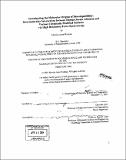Investigating the molecular origins of biocompatibility : intermolecular interactions between human serum albumin and various chemically modified surfaces via high resolution force spectroscopy
Author(s)
Rixman, Monica Anne, 1977-
DownloadFull printable version (8.170Mb)
Other Contributors
Massachusetts Institute of Technology. Dept. of Materials Science and Engineering.
Advisor
Christine Ortiz.
Terms of use
Metadata
Show full item recordAbstract
The first step in two of the most troublesome biological responses to the implantation of blood-contacting biomaterials, i.e. thrombosis and inflammation, is the adhesion of blood plasma proteins to the biomaterial surface, which may then initiate platelet adhesion and activation, and thereby set in motion a cascade of adverse host responses. If devices could be developed that prevent that first step from occurring altogether, a new generation of "stealth" biomaterials would be born. Such was the motivation of this project, which sought to investigate the constituent intermolecular interaction forces governing protein adhesion to biomaterials, using the technique of high resolution force spectroscopy. The model protein chosen for our study was human serum albumin (HSA), the smallest and most abundant blood protein in the human body, and typically the first to adsorb to a blood-contacting, implanted device. In the first stage of our investigation, HSA was covalently grafted to a nanosized probe tip at the end of a soft, microfabricated cantilever force transducer. The intermolecular interaction potential, U(D), was recorded between the HSA-modified probe tip and four different model surfaces, including: 1) gold, 2) a hydrophobic, CH3-terminated alkanethiol self-assembling monolayer (SAM), 3) a hydrophilic, COO-terminated alkanethiol SAM, and 4) individual, covalently end-grafted molecules of poly(ethylene oxide), in aqueous sodium phosphate buffer solution (PBS, ionic strength IS = 0.01M, pH = 7.4). Both theoretical and numerical modeling were employed to evaluate the experimental results on each of the different surfaces, and to characterize the nature of the protein-bound probe tip. In the second part of this study, (cont.) we aimed to elucidate the various constituent intermolecular interaction forces contributing to U(D) by strategically manipulating experimental conditions such that we were able to isolate, and in some cases quantify, the electrostatic, steric, and hydrophobic components. It was found theoretically that electrostatic and steric forces accounted for approximately 8% and 4% of the total intermolecular interaction force; experimentally, these forces are observed to be completely dominated by a repulsive force which increases in magnitude as the ionic strength of the solution is increased. It is believed that this additional force is imparted by the PEO, and may be due to a change in the conformation of the PEO coil, or the structure of the network of water molecules in the space between the PEO coil and the approaching probe tip. The hydrophobic component was experimentally quantified to be approximately 20% of the total intermolecular interaction force at D [approx.] 1 nm. In the third part of this investigation, we sought to study the interactions between HSA and a series of oligosaccharide-functionalized surfaces inspired by the glycocalyx, which coats all living cells and is naturally and necessarily hemocompatible. The results of this study were then compared to experiments conducted in parallel on poly- and oligo(ethylene oxide) modified surfaces. Our results suggest that higher oligosaccharides ...
Description
Thesis (Ph. D.)--Massachusetts Institute of Technology, Dept. of Materials Science and Engineering, February 2004. Includes bibliographical references (p. 200-215).
Date issued
2004Department
Massachusetts Institute of Technology. Department of Materials Science and EngineeringPublisher
Massachusetts Institute of Technology
Keywords
Materials Science and Engineering.